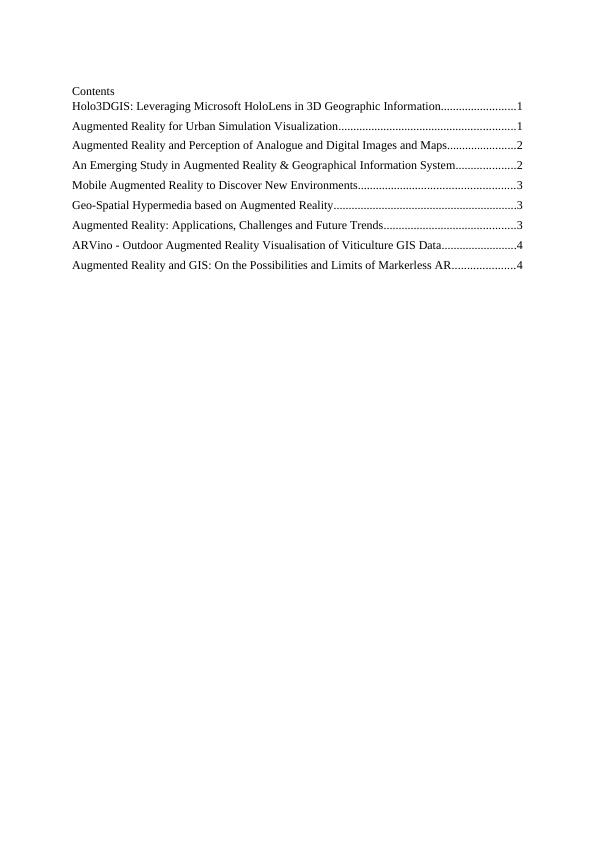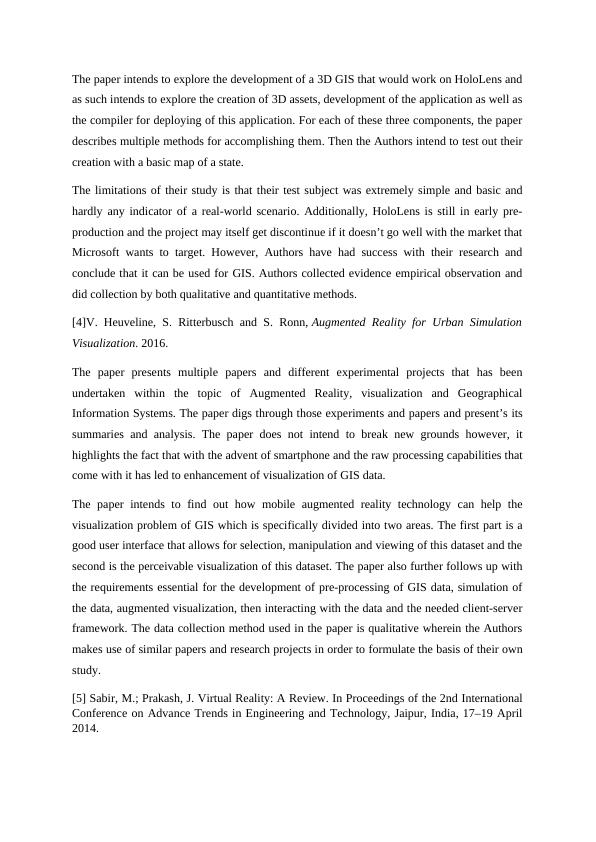Augmented Reality and GIS: A Review of Applications and Future Trends
Annotated Bibliography on the topic of natural hazards and flood risk assessment metrics
7 Pages2695 Words119 Views
Added on 2023-06-14
About This Document
This article reviews the latest research and applications of combining Augmented Reality and GIS technology. It covers topics such as Holo3DGIS, mobile augmented reality, and geo-spatial hypermedia. The article also discusses the limitations and challenges of this technology and its future trends. Find study material, solved assignments, essays, and dissertations on Desklib.
Augmented Reality and GIS: A Review of Applications and Future Trends
Annotated Bibliography on the topic of natural hazards and flood risk assessment metrics
Added on 2023-06-14
ShareRelated Documents
Contents
Holo3DGIS: Leveraging Microsoft HoloLens in 3D Geographic Information.........................1
Augmented Reality for Urban Simulation Visualization...........................................................1
Augmented Reality and Perception of Analogue and Digital Images and Maps.......................2
An Emerging Study in Augmented Reality & Geographical Information System....................2
Mobile Augmented Reality to Discover New Environments....................................................3
Geo-Spatial Hypermedia based on Augmented Reality.............................................................3
Augmented Reality: Applications, Challenges and Future Trends............................................3
ARVino - Outdoor Augmented Reality Visualisation of Viticulture GIS Data.........................4
Augmented Reality and GIS: On the Possibilities and Limits of Markerless AR.....................4
Holo3DGIS: Leveraging Microsoft HoloLens in 3D Geographic Information.........................1
Augmented Reality for Urban Simulation Visualization...........................................................1
Augmented Reality and Perception of Analogue and Digital Images and Maps.......................2
An Emerging Study in Augmented Reality & Geographical Information System....................2
Mobile Augmented Reality to Discover New Environments....................................................3
Geo-Spatial Hypermedia based on Augmented Reality.............................................................3
Augmented Reality: Applications, Challenges and Future Trends............................................3
ARVino - Outdoor Augmented Reality Visualisation of Viticulture GIS Data.........................4
Augmented Reality and GIS: On the Possibilities and Limits of Markerless AR.....................4

Keywords - AR, GIS, Microsoft HoloLens, 3D GIS, Holo3DGIS
[1] P. Ghadirian and I. Bishop, "Composition of Augmented Reality and GIS To Visualize
Environmental Changes", Joint AURISA and Institution of Surveyors Conference, vol. 2, no.
2, 2002.
In this article, authors Payam Ghadirian1and Ian D. Bishop presents early phases of a project
in which GIS, based on environment process modelling, with the Augmented Reality
technology. A project which can facilitate amenities of current system i.e. Geo-reference GIS,
3D modelling with the 3D immersion system can overcome various problems of current
system. The article intends to create more realistic simulations of the ever-evolving systems.
The article evaluates the current visualization systems and also introduces fundamentals of
existing proposed system. It also explains the proposed weed spread case along with key
observations in multi-channel video capture. The article is at a very beginning step in figuring
out the capabilities of combined system consisting of GPS, GIS and Augment Reality.
However, it is possible only by improving communication among public which will lead to
development of more public exposure and participation.
[2] F. Liarokapis, I. Greatbatch, J. Raper, D. Mountain, V. Brujic-Okretic, A. Gunesh and V.
Brujic-Okretic, Mobile Augmented Reality Techniques for GeoVisualisation. 2018.
In this article, authors - Fotis Liarokapis, Ian Greatbatch, David Mountain, Anil Gunesh,
Vesna Brujic-Okretic and Jonathan Raper – presents the very first prototype of an interactive
visualization system which is specifically designed for showing the geographical data of both
indoor and outdoor platforms. The objective of the article is to make a 3D scene around the
user of the mobile at a prescribed height and data using photogrammetry and GIS techniques.
The second objective is to show the modelled data into a mixed realtime environment which
has two different visualization interfaces: VR mobile and tangible AR interfaces. The authors
have proved their objectives by implementing an experimental educational application known
as 3D puzzle. They have chosen human interaction method as the basis their research and
finding results. The article limits on the number of types of interactions that can be made and
intends to figure them out in their future work.
[3] W. Wang, Z. Chen and G. Chen, Holo3DGIS: Leveraging Microsoft HoloLens in 3D
Geographic Information. 2018.
The paper aims to make use of Microsoft’s HoloLens for interacting and exploring GIS.
HoloLens is a next generation AR technology developed by Microsoft. The paper presents
and explores this technology and it’s significant because HoloLens is a more advanced
technology compared to traditional ARs and has excellent capabilities when it comes to AR.
These features include exception 3D display, gesture design, gaze design, spatial mapping
and spatial sound design (16). Thereby HoloLens has been used in many different areas of
research and development (20).
[1] P. Ghadirian and I. Bishop, "Composition of Augmented Reality and GIS To Visualize
Environmental Changes", Joint AURISA and Institution of Surveyors Conference, vol. 2, no.
2, 2002.
In this article, authors Payam Ghadirian1and Ian D. Bishop presents early phases of a project
in which GIS, based on environment process modelling, with the Augmented Reality
technology. A project which can facilitate amenities of current system i.e. Geo-reference GIS,
3D modelling with the 3D immersion system can overcome various problems of current
system. The article intends to create more realistic simulations of the ever-evolving systems.
The article evaluates the current visualization systems and also introduces fundamentals of
existing proposed system. It also explains the proposed weed spread case along with key
observations in multi-channel video capture. The article is at a very beginning step in figuring
out the capabilities of combined system consisting of GPS, GIS and Augment Reality.
However, it is possible only by improving communication among public which will lead to
development of more public exposure and participation.
[2] F. Liarokapis, I. Greatbatch, J. Raper, D. Mountain, V. Brujic-Okretic, A. Gunesh and V.
Brujic-Okretic, Mobile Augmented Reality Techniques for GeoVisualisation. 2018.
In this article, authors - Fotis Liarokapis, Ian Greatbatch, David Mountain, Anil Gunesh,
Vesna Brujic-Okretic and Jonathan Raper – presents the very first prototype of an interactive
visualization system which is specifically designed for showing the geographical data of both
indoor and outdoor platforms. The objective of the article is to make a 3D scene around the
user of the mobile at a prescribed height and data using photogrammetry and GIS techniques.
The second objective is to show the modelled data into a mixed realtime environment which
has two different visualization interfaces: VR mobile and tangible AR interfaces. The authors
have proved their objectives by implementing an experimental educational application known
as 3D puzzle. They have chosen human interaction method as the basis their research and
finding results. The article limits on the number of types of interactions that can be made and
intends to figure them out in their future work.
[3] W. Wang, Z. Chen and G. Chen, Holo3DGIS: Leveraging Microsoft HoloLens in 3D
Geographic Information. 2018.
The paper aims to make use of Microsoft’s HoloLens for interacting and exploring GIS.
HoloLens is a next generation AR technology developed by Microsoft. The paper presents
and explores this technology and it’s significant because HoloLens is a more advanced
technology compared to traditional ARs and has excellent capabilities when it comes to AR.
These features include exception 3D display, gesture design, gaze design, spatial mapping
and spatial sound design (16). Thereby HoloLens has been used in many different areas of
research and development (20).

The paper intends to explore the development of a 3D GIS that would work on HoloLens and
as such intends to explore the creation of 3D assets, development of the application as well as
the compiler for deploying of this application. For each of these three components, the paper
describes multiple methods for accomplishing them. Then the Authors intend to test out their
creation with a basic map of a state.
The limitations of their study is that their test subject was extremely simple and basic and
hardly any indicator of a real-world scenario. Additionally, HoloLens is still in early pre-
production and the project may itself get discontinue if it doesn’t go well with the market that
Microsoft wants to target. However, Authors have had success with their research and
conclude that it can be used for GIS. Authors collected evidence empirical observation and
did collection by both qualitative and quantitative methods.
[4]V. Heuveline, S. Ritterbusch and S. Ronn, Augmented Reality for Urban Simulation
Visualization. 2016.
The paper presents multiple papers and different experimental projects that has been
undertaken within the topic of Augmented Reality, visualization and Geographical
Information Systems. The paper digs through those experiments and papers and present’s its
summaries and analysis. The paper does not intend to break new grounds however, it
highlights the fact that with the advent of smartphone and the raw processing capabilities that
come with it has led to enhancement of visualization of GIS data.
The paper intends to find out how mobile augmented reality technology can help the
visualization problem of GIS which is specifically divided into two areas. The first part is a
good user interface that allows for selection, manipulation and viewing of this dataset and the
second is the perceivable visualization of this dataset. The paper also further follows up with
the requirements essential for the development of pre-processing of GIS data, simulation of
the data, augmented visualization, then interacting with the data and the needed client-server
framework. The data collection method used in the paper is qualitative wherein the Authors
makes use of similar papers and research projects in order to formulate the basis of their own
study.
[5] Sabir, M.; Prakash, J. Virtual Reality: A Review. In Proceedings of the 2nd International
Conference on Advance Trends in Engineering and Technology, Jaipur, India, 17–19 April
2014.
as such intends to explore the creation of 3D assets, development of the application as well as
the compiler for deploying of this application. For each of these three components, the paper
describes multiple methods for accomplishing them. Then the Authors intend to test out their
creation with a basic map of a state.
The limitations of their study is that their test subject was extremely simple and basic and
hardly any indicator of a real-world scenario. Additionally, HoloLens is still in early pre-
production and the project may itself get discontinue if it doesn’t go well with the market that
Microsoft wants to target. However, Authors have had success with their research and
conclude that it can be used for GIS. Authors collected evidence empirical observation and
did collection by both qualitative and quantitative methods.
[4]V. Heuveline, S. Ritterbusch and S. Ronn, Augmented Reality for Urban Simulation
Visualization. 2016.
The paper presents multiple papers and different experimental projects that has been
undertaken within the topic of Augmented Reality, visualization and Geographical
Information Systems. The paper digs through those experiments and papers and present’s its
summaries and analysis. The paper does not intend to break new grounds however, it
highlights the fact that with the advent of smartphone and the raw processing capabilities that
come with it has led to enhancement of visualization of GIS data.
The paper intends to find out how mobile augmented reality technology can help the
visualization problem of GIS which is specifically divided into two areas. The first part is a
good user interface that allows for selection, manipulation and viewing of this dataset and the
second is the perceivable visualization of this dataset. The paper also further follows up with
the requirements essential for the development of pre-processing of GIS data, simulation of
the data, augmented visualization, then interacting with the data and the needed client-server
framework. The data collection method used in the paper is qualitative wherein the Authors
makes use of similar papers and research projects in order to formulate the basis of their own
study.
[5] Sabir, M.; Prakash, J. Virtual Reality: A Review. In Proceedings of the 2nd International
Conference on Advance Trends in Engineering and Technology, Jaipur, India, 17–19 April
2014.

End of preview
Want to access all the pages? Upload your documents or become a member.
